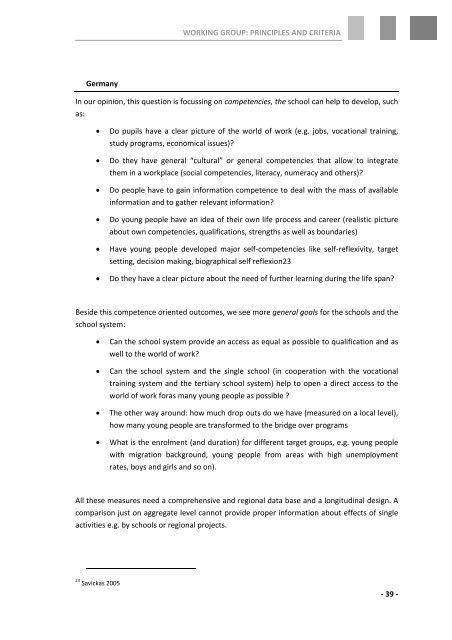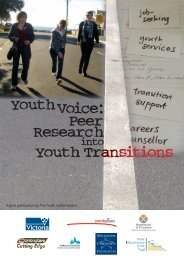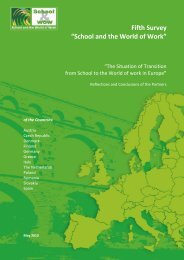Second Survey School and WOW.pdf
Second Survey School and WOW.pdf
Second Survey School and WOW.pdf
Create successful ePaper yourself
Turn your PDF publications into a flip-book with our unique Google optimized e-Paper software.
WORKING GROUP: PRINCIPLES AND CRITERIA<br />
Germany<br />
In our opinion, this question is focussing on competencies, the school can help to develop, such<br />
as:<br />
<br />
<br />
<br />
<br />
<br />
<br />
Do pupils have a clear picture of the world of work (e.g. jobs, vocational training,<br />
study programs, economical issues)?<br />
Do they have general “cultural” or general competencies that allow to integrate<br />
them in a workplace (social competencies, literacy, numeracy <strong>and</strong> others)?<br />
Do people have to gain information competence to deal with the mass of available<br />
information <strong>and</strong> to gather relevant information?<br />
Do young people have an idea of their own life process <strong>and</strong> career (realistic picture<br />
about own competencies, qualifications, strengths as well as boundaries)<br />
Have young people developed major self‐competencies like self‐reflexivity, target<br />
setting, decision making, biographical self reflexion23<br />
Do they have a clear picture about the need of further learning during the life span?<br />
Beside this competence oriented outcomes, we see more general goals for the schools <strong>and</strong> the<br />
school system:<br />
<br />
<br />
<br />
<br />
Can the school system provide an access as equal as possible to qualification <strong>and</strong> as<br />
well to the world of work?<br />
Can the school system <strong>and</strong> the single school (in cooperation with the vocational<br />
training system <strong>and</strong> the tertiary school system) help to open a direct access to the<br />
world of work foras many young people as possible ?<br />
The other way around: how much drop outs do we have (measured on a local level),<br />
how many young people are transformed to the bridge over programs<br />
What is the enrolment (<strong>and</strong> duration) for different target groups, e.g. young people<br />
with migration background, young people from areas with high unemployment<br />
rates, boys <strong>and</strong> girls <strong>and</strong> so on).<br />
All these measures need a comprehensive <strong>and</strong> regional data base <strong>and</strong> a longitudinal design. A<br />
comparison just on aggregate level cannot provide proper information about effects of single<br />
activities e.g. by schools or regional projects.<br />
23 Savickas 2005<br />
‐ 39 ‐




